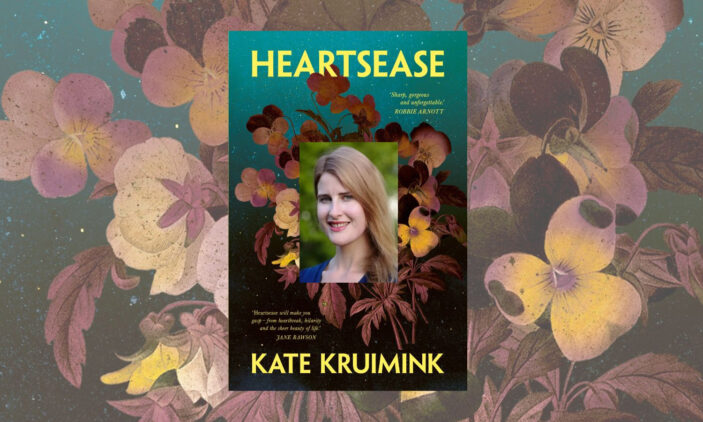
I recently spoke to Kat Kruimink about her brand new novel, Heartsease, a complicated book about familial ties, friendships, flowers, grief, trauma, memory, ghosts, and sisterly love. You can read my review of the book HERE, and read on for our interview!
Hi Kate, thank you so much for taking time out of your day to answer some of my questions regarding your new book, Heartsease.
It’s a pleasure!
To start off with, would you mind telling us a little about your book, Heartsease?
Heartsease is a book set in present-day Hobart. It’s about familial ties and trauma, grief, memory, ghosts, and, I reckon, also love. It told through the perspectives of two sisters and over two timelines, which are both interleaved.
Where did the inspiration for Heartsease come from and how did you go about creating it? What were the steps that you took in creating this story? Were the characters the first thing you created or was it the plot or something else?
Well, it began life back in the mists of time as a thematically related, but quite different, attempt at a book about a woman called Ellen Llewellyn who is dysfunctional and then has a traumatic experience that makes things harder. The traumatic experience was something that I had experienced too, but I was too close to it all to write about it. I needed to let a good decade or so go by before I really had the maturity to write about it. And by that time, it had become something different. The themes of the book are personal to me, but it’s not my story; the story is just the doorway into the ideas behind it.
I’m not a very organised writer, so I can’t say there were any particular steps that I took. I’ve tried Scrivenor, and it’s great, but it’s just too organised for me. The way I wrote this book is how I write all my fiction. I began writing, and then the ideas and the characters and the dialogue all clunked into place and the story developed a logic of its own that I could just follow.
Has being the fiction editor at Island Magazine impacted your creative process, decisions, or inspiration of Heartsease, or your writing practice in general?
Ah, well, I now have less time to write, which is an impact! I haven’t been doing it for very long, so if it manifests somehow in my writing, I think that’s something that will happen slowly, over time. This is a great question, though, and I can’t imagine that it won’t affect my writing. Any experience worth anything influences the writing.
Throughout your writing process, did you have any central questions that you were trying to answer, if so, what were they, and how have they changed to the book’s final published central question? Did it change throughout the writing process?
The core thing I was interested in was memory. Memory is a bit like Schrödinger’s cat, maybe; simultaneously true and untrue. Have you ever had that experience where you recount a memory from long ago to a sibling, only for your sibling to tell you that it’s not true, and that’s not how it happened?
The other kind of memory I’m interested in is muscle memory. There are ghosts in my book, and I explain them through muscle memory: maybe your eyes become so used to seeing someone and your brain to processing that image that these parts of your body simply remember, and present you with the image of someone who has died. And how does muscle memory function with regard to organ donation? My mother was an organ donor, and I hadn’t ever really thought about it before, other than to register when I turned 18 because it seemed like a good thing to do. What a gift, to have some hope and some real and tangible good come from death. And what an extraordinary continuation of life, to let someone create their own muscle memory, their own relationship and interchange, with organs that were once yours.
I believe that within your novel, the characters feel so personal, well created, and complex. Where did your inspiration for your characters come from, how did you go about creating them?
Well thank you! There is a lot of me in both sisters, necessarily, I guess. I don’t think you can get away from yourself as a writer. I think you give yourself away. Even in my first book, which I wrote very specifically as a reaction against myself, the character who I had tried to make my opposite became, in fact, kind of me, or at least an aspect of me. So: megalomania?
It comes from observation, of course. I think a lot of writers hold themselves back a bit, like they have a responsibility to observe and report back. Like the one who takes the minutes at a meeting.
Why did you choose to tell the story and structure it where the past and present, Charlotte (Lot) and Ellen (Nelly), alternate between each chapter? What does this structure and play with time have to offer in comparison to sticking with one sister and one time? Did you experiment between the two?
Great question. I fumbled with this for a while. I was always going to tell this story through two voices, but I was really uncertain about how to present them. The timelines follow one from the other; linearly, the younger sister’s story begins and ends and then the older sister’s story begins. But it felt inauthentic to portray it that way (and a bit boring). I toyed with the idea with moving backward in time, with beginning with the second story and then the first after that, but really the thing I was drawn to was interleaving them. The reason for this is simple! We don’t live linearly. I think we live partly in the present and a whole lot in the past, with an undercurrent of future always there. Moving back and forth between the two stories and the two timelines felt like it was slightly closer to real experience.
I think we can both agree that the comedy within your book, Heartsease, sometimes borders dark humour. Why did you include so much of it, especially in times of discomfort? And generally, why did you choose to include so much humour within your story and not just leave it as a dark, gruesome, and morbid story, perhaps like a traditional emotional and grief-stricken story?
I would say often borders on dark humour! Humour and grief are perhaps opposites, but opposites reference each other; they need each other for their very definition. So, there is already a connection there. What’s really relevant here, though, is the consolation of humour. To laugh with someone is this pure, primal connection. It’s togetherness when it’s most needed. Grief can be so lonely. My mother died in 2017, very suddenly, although she spent a day and a night or so in the ICU before she was legally dead. During this time, there was a constant stream of friends and family were coming and going, and I have this enduring memory of a motley band of loved ones, people who wouldn’t normally meet, people from different parts of our lives, and they were just in stitches there in the waiting room over the coffin brochure (leopard print! Hot pink!). It was such a burst of colour and comfort.
There is a quote I would like to share, a conversation between Lot and Nelly:
“‘It’s not internalised misogyny to walk to your car with your key in your fist ready to stab some fucker in the eye,’ said Lot. ‘You must write that down,’ [says Nelly].”
How did you come up with this and the many other funny and witty comments or conversations throughout the book? Did real conversations or people within your life inspire this, therefore you wrote them down for later, or are you just naturally funny?
Ha, this is tough to answer! Humour is always hard to pin down. You lose it if you put a magnifying glass over it. No, I don’t use real conversations. When I’m writing, if it’s working, the dialogue – like the logic of the story – will do that same clunk into place, and it will flow quite naturally. It’s like finding the spark when you’re talking to someone who really, really, gets you, who’s on the same wavelength, who you enjoy.
Charlotte (Lot) says:
“‘People have been angsting since the dawn of time.’”
Is this book a manifestation of your own inner angst? Is Heartsease intended to be read angsty? One that people can bond over and relate to?
It’s not intended to be explicitly angsty. My hope was only to tell a story that felt authentic. I don’t have a thesis, other than those vague ponderings about memory I mentioned. It’s a sad story, about sad and funny and well-meaning people, so I hope more the latter part of your question – that there will be some relatability there, or at least some recognition.
What would you like readers to keep in mind when reading your book? Is there something you want them to know before they pick it up, or as they read it? And upon finishing it, what would you then like readers to takeaway with them?
I always just want readers to approach it with an open mind. If someone reads it and is willing to suspend disbelief and look at what I’m trying to do, I’m grateful.
What was your favourite and most disliked part about writing Heartsease?
Well, it’s not so much about the writing, but I loved seeing the cover, all beautifully typeset and finished. It sparkles a bit in the light; they’ve done some clever effect over some of the stars. It’s perfect. My most disliked part … the self-doubt, maybe?
Why did you choose to compare the sisters with flowers? Do heartsease and roses represent something significant to you personally?
No, although heartsease has that overt connection with consolation and comfort. The character of the mother, Nina, is such a prickly and difficult person, and she exists only in memory, so she can’t actively redeem herself in the action of the novel. Nelly, the younger sister, is the one who talks about her the most. They had a really tricky relationship, so we see Nina mostly through the eyes of the one who misunderstood her the most, and who was misunderstood by her. There needed to be some symbol that could exist in Nelly’s memory without her understanding it, that would represent her mother’s love and attempts at care. Something that Nelly could understand later, with help. So I had Nina plant a flower to represent each of her daughters. Charlotte’s is this gorgeous big showy rose that looks great in a vase, which is easy to understand, but Nelly’s is a little more obtuse: it’s a funny little annual that grows close to the ground. It takes Nelly the whole course of the book to understand what it means. I won’t spoil it, but maybe readers can guess.
Some authors say that their characters or story that they have created stay with them for some time or became a part of them. Would you say that is the case for you? Do you often think about them in your day-to-day life?
Yes, because they came from something that was already a part of me.
Do you have any final words you would like to share before we conclude todays interview? Where can people find you if they want to find out more about you?
Just thank you for your time and these wonderful questions. I’m on Instagram @katekruimink.
—–
Heartsease by Kate Kruimink is out now from Picador. Get yourself a copy from Booktopia HERE. Read my review HERE!
